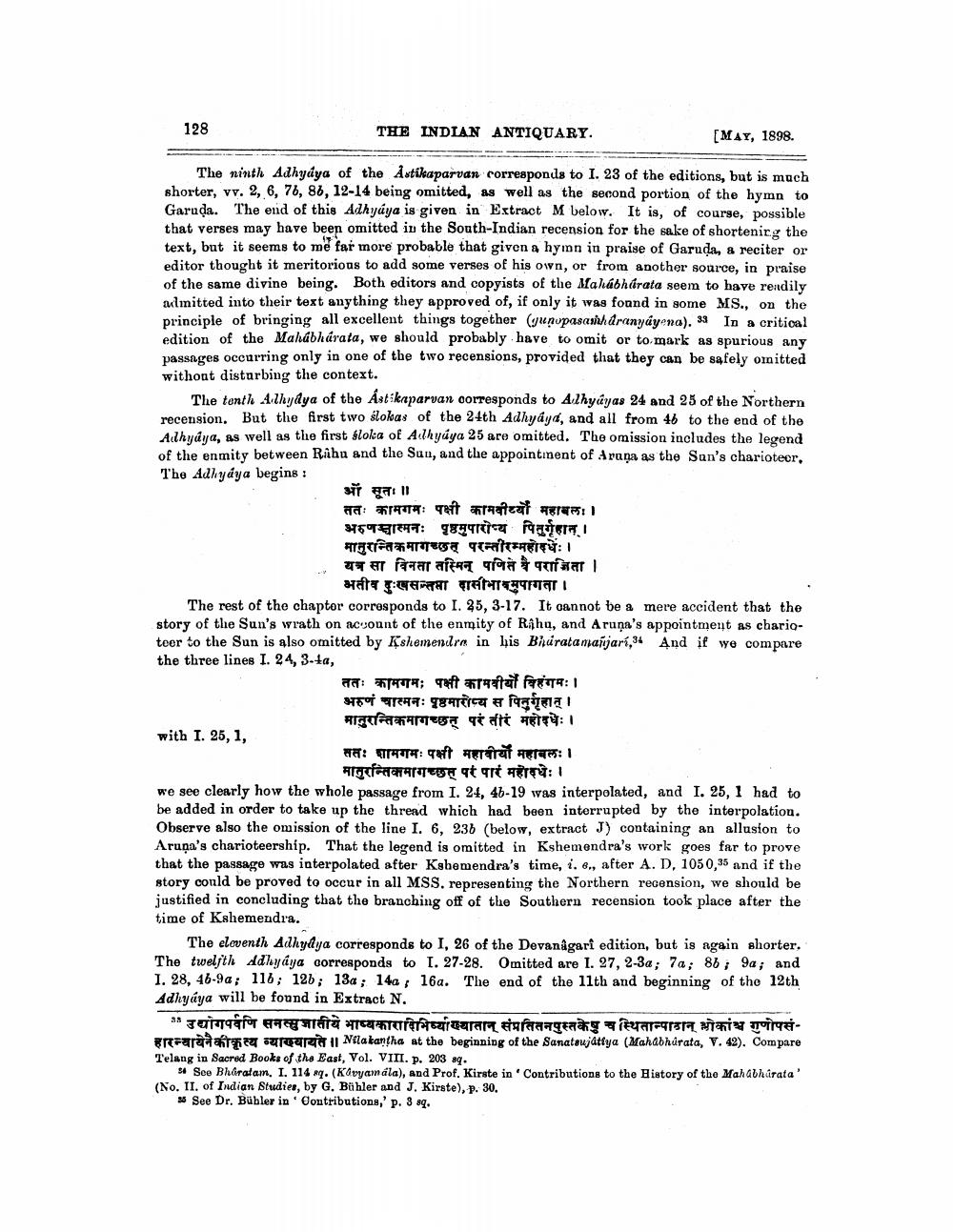________________
128
THE INDIAN ANTIQUARY.
[MAY, 1898.
The ninth Adhydya of the Astikaparvan corresponds to I. 23 of the editions, but is much shorter, vv. 2, 6, 76, 86, 12-14 being omitted, as well as the second portion of the hymn to Garuda. The end of this Adhyâya is given in Extract M below. It is, of courge, possible that verses may have been omitted in the South Indian recension for the sake of shortening the text, but it seems to me far more probable that given a hymn in praise of Garuda, & reciter or editor thought it meritorious to add some verses of his own, or from another source, in praise of the same divine being. Both editors and copyists of the Mahabharata seem to have readily almitted into their text anything they approved of, if only it was found in some MS., on the principle of bringing all excellent things together (yunupasanih aranyáyena). 33 In a critical edition of the Mahabharata, we should probably have to omit or to mark as spurious any passages occurring only in one of the two recensions, provided that they can be safely omitted without disturbing the context.
The tenth Alhydya of the Astikaparvan corresponds to Alhyâyas 24 and 25 of the Northern recension. But the first two ślokas of the 24th Adhyây, and all from 46 to the end of the Adhyâya, as well as the first floka of Allhyáya 25 are omitted. The omission includes the legend of the enmity between Riha and the Sun, and the appointment of Araña as the Sun's charioteer, The Adhyâya begins :
iT 11 ततः कामगमः पक्षी कामवीटयों महाबलः। अरुणचारमनः पृष्ठमुपारोग्य पितुर्गहान । मानुन्तिकमागच्छत् परन्तीरम्महोदधेः। यत्र सा विनता तस्मिन् पणिते वै पराजिता ।
भतीव दुःखसन्तप्ता दासीभावमुपागता। The rest of the chaptor corresponds to I. 25, 3-17. It cannot be a mere accident that the story of the Sun's wrath on account of the enmity of Rahu, and Aruna's appointment as chariotoer to the Sun is also omitted by Kshemenilra in his Bhuratamañjarí,34 And if we compare the three lines I. 24, 3-ta,
ततः कामगमः पक्षी कामवीर्यों विहंगमः। अरुणं चास्मनः पृष्ठमारोप्य स पिनुगृहात् ।
मानुरन्तिकमागच्छत् परं तीरं महोदधेः। with I. 25, 1,
सतः शामगमः पक्षी महावीयों महाबलः।
मासुरन्तिकमागच्छत् परं पारं महोदयः। we see clearly how the whole passage from I. 24, 46-19 was interpolated, and I. 25, 1 had to be added in order to take up the thread which had been interrupted by the interpolation. Observe also the omission of the line I. 6, 236 (below, extract J) containing an allusion to Aruña's charioteership. That the legend is omitted in Kshemendra's work goes far to prove that the passage was interpolated after Kshemendra's time, i. 6., after A. D, 1050,35 and if the story conld be proved to occur in all MSS. representing the Northern recension, we should be justified in concluding that the branching off of the Southern recension took place after the time of Kshemendra.
The eleventh Adkydya corresponds to I, 26 of the Devanagari edition, but is again shorter, The twelfth Adhyâya corresponds to I. 27-28. Omitted are I. 27, 2-3a; 7a; 86, 9a; and 1. 28, 46-9a; 116; 126; 13a; 14a, 16a. The end of the 11th and beginning of the 12th Adhyáya will be found in Extract N.
उद्योगपर्वणि समत्सुजातीये भाष्यकारादिभियाण्थातान् संप्रतितनपुस्तकेषु च स्थितान्पाठान भोकांश्च गुणोपसंgraria arity suret li Nilakantha at the beginning of the Sanatoujattya (Mahabharata, V. 42). Compare Telang in Sacred Books of the East, Vol. VIII. p. 203 sq.
1 See Bharatam. I. 114 np. (Kavyamála), and Prof. Kirste in Contributions to the History of the Mahabhúrata' (No. II. of Indian Studies, by G. Bühler and J. Kirste), P. 30.
» See Dr. Bübler in 'Contributions,' p. 3 89.




